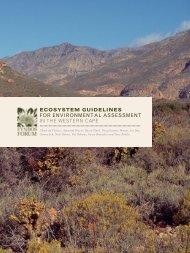Chapter 1 - University of the Western Cape
Chapter 1 - University of the Western Cape
Chapter 1 - University of the Western Cape
You also want an ePaper? Increase the reach of your titles
YUMPU automatically turns print PDFs into web optimized ePapers that Google loves.
ened. So great is <strong>the</strong> concern over<br />
<strong>the</strong> rate <strong>of</strong> decline, and its implications<br />
for human welfare, that<br />
biodiversity was identified as one <strong>of</strong><br />
<strong>the</strong> five priority areas for <strong>the</strong> 2002<br />
World Summit on Sustainable<br />
Development (WSSD). 4<br />
A common strategy for biodiversity<br />
conservation has been identify<br />
priority areas and focus conservation<br />
efforts on those areas. e<br />
international system <strong>of</strong> national<br />
and regional protected areas is a<br />
clear example <strong>of</strong> this approach, and<br />
it is also implemented through a<br />
variety <strong>of</strong> international agreements:<br />
<strong>the</strong> Ramsar Convention produces<br />
a list <strong>of</strong> Wetlands <strong>of</strong> International<br />
Importance, and <strong>the</strong> World<br />
Heritage Convention identifies sites<br />
<strong>of</strong> natural heritage considered to be<br />
<strong>of</strong> outstanding value. Several international<br />
conservation organizations<br />
have also adopted this strategy:<br />
BirdLife International designates<br />
Important Bird Areas (IBAs),<br />
based, inter alia, on <strong>the</strong> presence<br />
<strong>of</strong> globally threatened or endemic<br />
species; and World Wildlife Fund<br />
(WWF) has defined a “Global<br />
200” set <strong>of</strong> priority conservation<br />
areas, with <strong>the</strong> central concept<br />
being to conserve <strong>the</strong> broadest variety<br />
<strong>of</strong> <strong>the</strong> world’s habitats and <strong>the</strong><br />
most endangered wildlife.<br />
1.3 Conservation International’s<br />
Priority-Setting Mechanisms:<br />
Biodiversity Hotspots, Wilderness<br />
Areas, and Coral Reef Hotspots<br />
CI has developed a priority-setting<br />
strategy that focuses its attention<br />
on biodiversity hotspots around <strong>the</strong><br />
world. CI notes that two factors are<br />
considered for hotspot designation:<br />
“Hotspots are regions that harbor<br />
a great diversity <strong>of</strong> endemic species<br />
and, at <strong>the</strong> same time, have been<br />
significantly impacted and altered<br />
by human activities” (Meyers, et.<br />
al. 2000).<br />
Plant diversity is <strong>the</strong> biological<br />
basis for hotspot designation—to<br />
qualify as a biodiversity hotspot, a<br />
region must support at least 1,500<br />
endemic plant species (0.5 percent<br />
<strong>of</strong> <strong>the</strong> global total). Existing<br />
primary vegetation is <strong>the</strong> basis for<br />
assessing human impact in a region,<br />
and a hotspot must have lost 70<br />
percent or more <strong>of</strong> its original habitat.<br />
Overall, <strong>the</strong> hotspots have lost<br />
nearly 90 percent <strong>of</strong> <strong>the</strong>ir original<br />
natural vegetation.<br />
e biodiversity hotspots<br />
contain 44 percent <strong>of</strong> all known<br />
endemic plant species and 35 percent<br />
<strong>of</strong> all known endemic species<br />
<strong>of</strong> birds, mammals, reptiles, and<br />
amphibians in only 1.4 percent <strong>of</strong><br />
<strong>the</strong> planet’s land area (Meyers, et.<br />
al. 2000).<br />
Given <strong>the</strong> great concentration<br />
<strong>of</strong> plant and animal species in such<br />
a small and highly threatened terrestrial<br />
fragment <strong>of</strong> <strong>the</strong> world, it<br />
is extremely important that <strong>the</strong>se<br />
areas receive very special conservation<br />
attention, along with research<br />
and monitoring to prevent fur<strong>the</strong>r<br />
extinctions.<br />
Map 1 illustrates <strong>the</strong> location <strong>of</strong><br />
each <strong>of</strong> <strong>the</strong> hotspots. e biodiversity<br />
hotspots span countries <strong>of</strong> different<br />
sizes, economic and resource<br />
endowments, and social contexts.<br />
Mass tourism, as well as naturebased<br />
and adventure tourism, is<br />
a significant revenue generator in<br />
many <strong>of</strong> <strong>the</strong>se countries.<br />
CI has also identified 10 coral<br />
reef hotspots. Eight <strong>of</strong> <strong>the</strong> 10 are<br />
adjacent to terrestrial biodiversity<br />
hotspots. Extending terrestrial conservation<br />
efforts seaward in those<br />
places <strong>of</strong>fers an effective and affordable<br />
strategy for protecting global<br />
biodiversity. Coral reef hotspots,<br />
many <strong>of</strong> which receive significant<br />
tourism volumes, are also identified<br />
in Map 1.<br />
An additional and complementary<br />
terrestrial prioritization<br />
category used by CI is that <strong>of</strong> wilderness<br />
areas. ree major tropical<br />
wilderness areas are shown in Map 1<br />
—Amazonia, <strong>the</strong> Congo Forest<br />
<strong>of</strong> Central Africa, and <strong>the</strong> island<br />
<strong>of</strong> New Guinea. ey are at least<br />
70 percent intact and are generally<br />
under less pressure from encroaching<br />
human populations than are<br />
<strong>the</strong> biodiversity hotspots, having<br />
fewer than five people per square<br />
kilometer. As such, <strong>the</strong>se areas<br />
are among <strong>the</strong> last places where<br />
indigenous people can maintain<br />
traditional lifestyles. ese wilderness<br />
areas are among <strong>the</strong> largest<br />
remaining tracts <strong>of</strong> pristine land on<br />
Earth but, compared to similarly<br />
intact desert, arctic, or boreal<br />
regions, <strong>the</strong>y hold a high proportion<br />
<strong>of</strong> <strong>the</strong> planet’s biodiversity.<br />
ey are also <strong>of</strong> crucial importance<br />
to climate regulation and watershed<br />
protection.<br />
1.4 Tourism Development and<br />
Biodiversity Conservation: Linkages<br />
and Disconnects<br />
e travel and tourism industry<br />
claims that it is well placed to contribute<br />
to sustainable development<br />
on <strong>the</strong> grounds that it<br />
TOURISM AND BIODIVERSITY: MAPPING TOURISM’S GLOBAL FOOTPRINT<br />
3
















